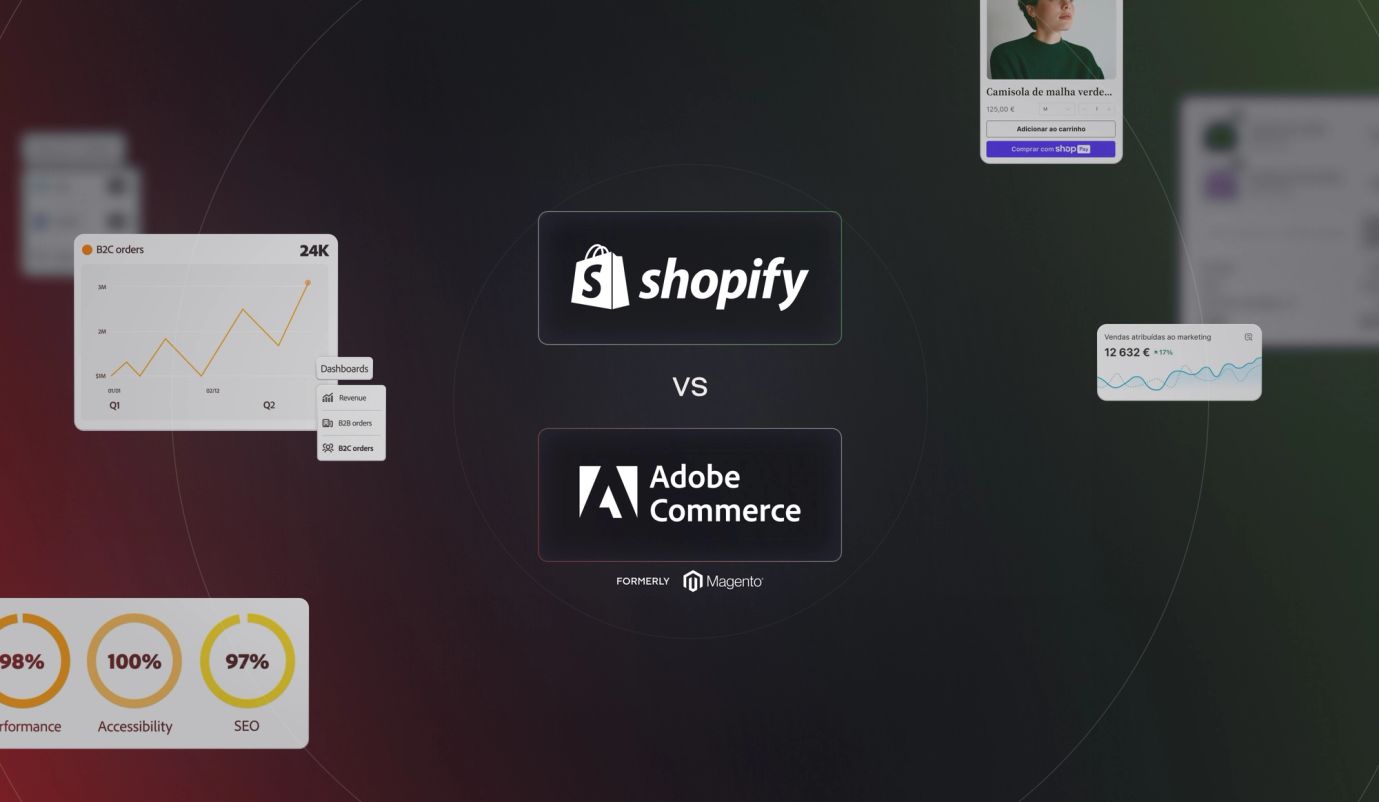
Which e-commerce platform is right for your business? We break down the key differences between Shopify and Magento in usability, scalability, pricing and long-term viability with expert insights and real-world comparisons.
Choosing the best platform for your business
Your e-commerce platform isn’t just a tool—it’s the foundation of your online business. The right choice can mean seamless scaling, effortless management and a better bottom line. The wrong choice? Well, that can lead to ongoing headaches, expensive development costs and unnecessary complexity.
Shopify and Magento (now Adobe Commerce) are two of the biggest names in e-commerce, but they cater to different needs. One is a fully hosted, plug-and-play solution designed for speed and ease of use. The other is an open-source, self-hosted platform that offers flexibility but demands significant technical resources.
So, which is right for your business? Let's break it down.
Shopify vs Magento: Which platform is more user-friendly?
Shopify is built for businesses that want to launch quickly and manage their store without hiring a development team. The drag-and-drop store builder, pre-designed themes and intuitive admin panel make it accessible to merchants of all sizes. Features like automated updates, built-in hosting and 24/7 customer support mean that technical maintenance is handled for you, allowing businesses to focus on growth. Shopify’s ecosystem also includes an expanding range of AI-powered tools, such as Shopify Magic, which helps merchants generate product descriptions and automate workflows.
Shopify's user-friendly interface is a major advantage for brands that want to scale fast. The ability to manage everything—from product uploads to order fulfillment—without technical expertise makes Shopify an easy choice for merchants who want to focus on selling, not problem-solving.
Magento, on the other hand, is a developer-first platform. Setting up Magento requires configuring servers, installing the software manually and optimising performance. While this flexibility allows for deep customisation, it also means that non-technical merchants face a steep learning curve. Even basic tasks like updating the store’s design or adding new features typically require custom development or third-party extensions. The added complexity makes Magento better suited for businesses with dedicated IT resources or those requiring highly specific custom workflows.
Shopify’s CMS makes store management easier for businesses that want a streamlined experience, while still offering the flexibility for custom development when needed.
Shopify vs Magento: Scalability and performance
Setbacks make all the difference when growth is the goal.
Shopify provides enterprise-grade scalability without merchants having to worry about infrastructure management. Shopify Plus, the platform’s enterprise solution, is designed to handle high-volume transactions, peak traffic spikes and global multi-store operations. Shopify’s 99.98% uptime, globally distributed CDN and automatic server scaling ensure that brands can continue growing without infrastructure bottlenecks. Businesses like Allbirds and Gymshark have leveraged Shopify to scale rapidly while maintaining sub-two-second page load speeds, which is crucial for conversion rates.
Unlike platforms that require extensive infrastructure upgrades as they scale, Shopify automatically adjusts server resources and optimises performance across its global cloud network. This means brands can launch seasonal campaigns, flash sales and influencer collaborations without worrying about site crashes or checkout failures.
Magento can scale effectively, but only if merchants actively manage server resources, caching and database performance. Large-scale operations require investments in dedicated hosting, performance tuning and frequent security updates to keep the store running smoothly. Without proper optimisation, Magento stores can experience slow load times and higher bounce rates, especially during high-traffic events like Black Friday. Businesses looking to scale globally with Magento must also configure their own CDN and cloud hosting, often requiring DevOps support.
For brands prioritising long-term growth without added complexity, Shopify offers a scalable infrastructure that eliminates the risks associated with performance bottlenecks.
Shopify vs Magento: Customisation & flexibility
Do you need ultimate control?
Magento is designed for brands that require total control over their store’s architecture. It offers custom workflows, complex product configurations and integrations beyond Shopify’s built-in tools. However, with this level of flexibility comes complexity—installing new extensions or updating Magento’s core software can sometimes cause compatibility issues that need developer intervention.
For brands that need fully custom checkout flows, product configurators or industry-specific workflows, Magento’s open-source framework allows for complete flexibility. However, this comes at a cost—updates to custom-built features often require extensive testing, and maintaining integrations requires dedicated development resources.
Shopify takes a structured approach to flexibility. Through Liquid templating and Shopify Functions, brands can customise their store’s front-end and business logic without modifying the platform’s core. Shopify’s headless commerce capabilities allow businesses to create unique storefronts while benefiting from Shopify’s security and scalability.
For 90% of businesses, Shopify offers all the flexibility needed without the overhead of managing custom code, server security or software updates. Brands that require extreme customisation may still prefer Magento, but Shopify provides a strong middle ground for brands that want to move fast.
Shopify vs Magento: pricing
Because hidden costs can make 'free' more expensive.
Magento’s open-source version is free, but the real costs lie in hosting, development and ongoing maintenance. Magento Commerce starts at $22,000 per year, and total costs, including a development team and hosting, can quickly exceed six figures.
Running a Magento store means investing in a high-performance server, dedicated security updates and an ongoing development retainer to maintain custom features. Brands that aren’t prepared for these costs often struggle with site speed, security patches and unexpected compatibility issues when upgrading.
Shopify follows a predictable pricing model. Standard plans range from $29 to $299 per month, with Shopify Plus starting at $2k+ per month. Shopify’s hosted infrastructure means brands don’t need to invest in server maintenance, security patches or performance tuning, significantly reducing long-term costs.
Adobe Commerce has 42% higher implementation and setup costs and 24% higher operating costs than Shopify. For growing businesses that need cost predictability, Shopify provides a lower total cost of ownership than Magento while eliminating unexpected expenses related to hosting, development and software maintenance.
Magento vs Shopify: Which has better apps and plugins?
The right tools give your store a competitive edge.
Shopify provides access to over 12,000 apps that extend store functionality. The Shopify App Store is carefully curated, ensuring that third-party solutions meet high standards for security, usability and effectiveness. These apps cover everything from advanced SEO optimisation and AI-driven customer engagement to subscription management and logistics automation. Shopify also natively integrates with Meta, Google, TikTok, Amazon and Klaviyo, making omnichannel selling seamless and scalable.
Magento has around 4,000 extensions, offering deep integrations, but installation can be more complex.
"Magento similarly has first-party and third-party integrations with lots of tech partners and marketing platforms including Klaviyo, Mailchimp, Meta and Google. Less popular platforms may be less likely to have ready-made integrations with Magento. It does provide the customisation for a developer to build custom integrations with other platforms as required."
– Alistair Shephard, Head of Development, Series Eight.
Shopify vs Magento: Global selling and shipping
It shouldn’t be complicated.
Shopify simplifies logistics with Shopify Shipping, which offers discounted carrier rates, real-time tracking and seamless label printing. Its multi-location inventory system allows merchants to track stock across warehouses and stores, reducing overselling and fulfilment delays. For international selling, Shopify Markets enables brands to manage currency conversions, taxes and region-specific checkout experiences, making cross-border commerce straightforward.
Magento provides robust inventory and shipping tools, but they depend heavily on third-party extensions. While Magento supports multi-store architecture, allowing businesses to create separate storefronts per region, setting up localisation features like unique pricing and tax compliance requires additional configuration and extensions. Compared to Shopify’s built-in global selling capabilities, Magento demands more technical oversight to manage international operations effectively.
Shopify vs Magento: Marketing features
Which platform turns more clicks into customers?
Shopify includes built-in SEO tools, automated email marketing integrations and seamless connections to advertising platforms like Google Ads and TikTok. Shopify’s marketing ecosystem allows brands to launch targeted campaigns, track customer behaviour and optimise conversions with minimal technical setup.
A strong example of Shopify’s marketing power is its abandoned cart recovery feature. Klaviyo’s dataset on abandoned cart emails reports an average open rate of 41.18%, a 9.50% click rate, and a revenue per recipient of $5.81, demonstrating the effectiveness of automated follow-ups in converting lost sales. By leveraging Shopify’s email automation and customer engagement tools, merchants can recapture revenue with minimal effort.
Magento supports advanced marketing strategies but relies on third-party extensions for SEO, email marketing and analytics. While Magento allows for deeper campaign customisation, merchants must manually install and configure tools like Google Tag Manager, email automation platforms and affiliate tracking software. Unlike Shopify, where these tools integrate natively, Magento users often require development support to implement advanced marketing automation. The additional effort required to optimise a Magento store for marketing makes Shopify a more accessible choice for brands looking to quickly scale their online presence without heavy technical input.
Shopify vs Magento: Security
It should be effortless, but some platforms make you work for it.
Shopify provides fully managed security with PCI DSS Level 1 compliance, fraud detection tools and automatic security patches. Because Shopify hosts all stores on its own secure cloud infrastructure, merchants don’t have to worry about managing SSL certificates, applying security updates or protecting against DDoS attacks. Shopify’s fraud protection algorithms help merchants identify high-risk transactions, reducing the chances of chargebacks and payment fraud.
Magento is also secure, but merchants are responsible for their own security updates, server protections and compliance measures. Since Magento is self-hosted, businesses must ensure their server is PCI compliant, update security patches regularly and monitor for vulnerabilities. Failing to update Magento’s core software can expose stores to potential exploits. In fact, security lapses in unpatched Magento stores have been a major cause of high-profile data breaches. Businesses running Magento need dedicated IT support or a managed hosting provider to maintain security at the same level as Shopify.
Magento vs Shopify: Which do experts recommend?
When it comes to expert recommendations, Shopify consistently ranks as the best choice for most businesses due to its ease of use, scalability, and comprehensive ecosystem.
Forbes Advisor notes that "Shopify is the best all-around e-commerce platform on the market today, offering a balance of usability, customization, and affordability that makes it ideal for businesses of all sizes." (Forbes)
TechRadar highlights Shopify’s user-friendliness and vast app ecosystem, stating that "Shopify’s intuitive design and extensive integrations make it a leading choice for merchants looking for a hassle-free way to launch and scale an online store." (TechRadar)
On the other hand, TechRadar describes Magento as "a powerful but complex platform best suited for enterprises with the resources to handle its development-heavy requirements." (TechRadar)
In independent user and business ratings, G2 ranks Shopify as the leading e-commerce platform, citing its reliability, extensive app ecosystem, and strong customer support, whereas Magento scores lower due to its complexity and maintenance requirements (G2).
Industry reviews make it clear: for businesses that want a low-maintenance, scalable, and intuitive solution, Shopify is the preferred choice, while Magento remains a viable option for enterprises with very specific development needs and in-house technical expertise.
Our opinion? Shopify all the way.
After years of working with brands at every stage of their e-commerce journey, we’ve seen firsthand the difference Shopify makes. It’s faster to launch, easier to manage and more cost-effective than Magento—without sacrificing scalability or flexibility. Shopify empowers brands to focus on growth, not website maintenance.

“Magento can be great for enterprises with development teams who need 100% control. For most businesses, however, Shopify’s simplicity makes it much easier to manage your store and website. Development is quicker and easier, and developers focus their time on your storefront instead of backend features. That Shopify is hosted is such a huge advantage, meaning you don’t have to worry about hosting, servers and traffic spikes!”
– Alistair Shepherd, Head of Development at Series Eight
Thinking of migrating?
Shopify’s migration tools ensure that customer data, order history, product catalogues, SEO settings, and site structure are transferred accurately so businesses can switch platforms without disruption. Shopify’s automated solutions help preserve your store’s structure, including product variants, collections, and customer profiles, so nothing gets lost in the transition. Beyond just data transfer, Shopify’s migration process ensures that your site architecture, metadata, and redirects are properly configured so you maintain SEO rankings and site performance from day one.
At Series Eight, we ensure a smooth transition by focusing on data integrity, storefront optimisation, and seamless integration with Shopify’s native tools and apps. Our expertise ensures your new store is not only functional from day one but also optimised for long-term growth. We replace previously custom-built Magento features, eliminating unnecessary custom development and reducing long-term costs. Shopify’s extensive app ecosystem replaces the need for complex, hard-coded solutions, allowing businesses to scale efficiently without ongoing developer intervention.
A successful migration isn’t just about moving data—it’s about ensuring your Shopify store is optimised for performance, usability, and growth. We ensure that previously custom workflows, integrations, and checkout experiences are translated effectively within Shopify’s framework.Our team ensures your Shopify store isn’t just a replica of your old Magento store—it’s an upgrade. We optimise for better efficiency, improved user experience, and long-term scalability, so you’re not just migrating—you’re future-proofing your business. Replatforming is more than just moving data—it’s an opportunity to streamline operations, improve site performance, and reduce long-term costs. Shopify ensures that brands migrating from Magento can focus on growth, not platform maintenance.
Ready to build a better online store?


